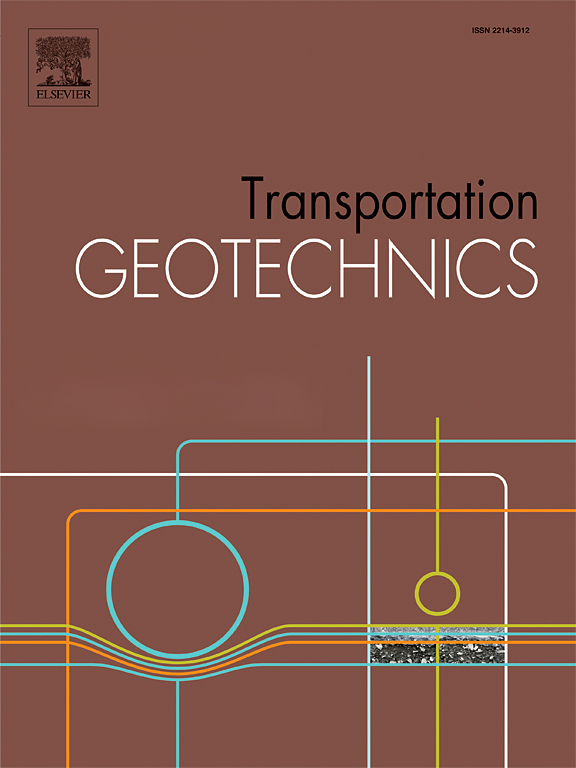可用于可持续道路基础设施的高早期强度微膨胀土工聚合物灌浆料性能评估
IF 4.9
2区 工程技术
Q1 ENGINEERING, CIVIL
引用次数: 0
摘要
本研究旨在开发一种源自再生混凝土和磨细高炉矿渣(GGBS)的高早强微膨胀土工聚合物灌浆材料,用于填充路基空隙和加固软弱路基。研究人员制备了一系列含有不同比例再生混凝土的灌浆材料,并对其凝结时间、流动性和强度特性进行了评估。结果表明,含有 50% 再生混凝土的灌浆材料的终凝时间为 29 分钟,流动时间为 15.2 秒,7 天抗压强度为 40.6 兆帕,均符合路基灌浆材料的要求。为了进一步提高灌浆料的性能,还使用了添加剂,包括 2 % 的氯化钙(CaCl2)、5 % 的氧化镁(MgO)和 5 % 的联合膨胀剂(UEA)。结果表明,含有 50 % 再生混凝土和 2 % CaCl2 的样品在 100 分钟养护后强度提高了 26.5%,而氧化镁和 UEA 则分别减少了 112.5 % 和 90.0 % 的收缩。此外,利用扫描电子显微镜和 XRD 进行的微观结构分析为了解成分之间复杂的相互作用及其对材料完整性的影响提供了宝贵的见解。结果表明,CaCl2 的使用加速了水化反应,提高了早期强度,而膨胀剂 MgO 和 UEA 则减轻了收缩,并在混凝土含量较低时实现了微膨胀。这项研究通过采用回收材料解决了环境问题,将所开发的土工聚合物灌浆料定位为道路建设中一种可持续的高性能替代材料。将废物衍生成分与创新添加剂相结合,是在基础设施建设中推进可持续发展实践的重要一步。本文章由计算机程序翻译,如有差异,请以英文原文为准。
Performance evaluation of high early strength micro-expansion geopolymer grout potentially used for sustainable road infrastructure
This study aimed to develop a high early strength micro-expansion geopolymer grout material derived from recycled concrete and ground granulated blast-furnace slag (GGBS), which can be used to fill the subgrade voids and strengthen weak subgrade. A series of grout materials with varying proportions of recycled concrete were prepared, and their setting time, flowability, and strength characteristics were evaluated. The results indicated that the grout material containing 50 % recycled concrete had a final setting time of 29 min, a flow time of 15.2 s, and a 7-day compressive strength of 40.6 MPa, all of which met the requirements for subgrade grout materials. To further enhance the performance of the grout, the additives including 2 % calcium chloride (CaCl2), 5 % magnesium oxide (MgO), and 5 % united expansive agent (UEA) were used. Results showed that the samples containing 50 % recycled concrete and 2 % CaCl2 exhibited a 26.5 % increase in strength after 100 min of curing, while MgO and UEA reduced shrinkage by 112.5 % and 90.0 %, respectively. Additionally, microstructural analysis using SEM and XRD provided valuable insights into the complex interactions between components and their effects on material integrity. The results demonstrated that the use of CaCl2 accelerated the hydration reaction, enhancing early strength, while the expansion agents MgO and UEA mitigated shrinkage and achieved micro-expansion at low concrete content. This study addresses environmental concerns by incorporating recycled materials, positioning the developed geopolymer grout as a sustainable, high-performance alternative in road construction. Integrating waste-derived components and innovative additives represents a significant step towards advancing sustainable practices in infrastructure development.
求助全文
通过发布文献求助,成功后即可免费获取论文全文。
去求助
来源期刊

Transportation Geotechnics
Social Sciences-Transportation
CiteScore
8.10
自引率
11.30%
发文量
194
审稿时长
51 days
期刊介绍:
Transportation Geotechnics is a journal dedicated to publishing high-quality, theoretical, and applied papers that cover all facets of geotechnics for transportation infrastructure such as roads, highways, railways, underground railways, airfields, and waterways. The journal places a special emphasis on case studies that present original work relevant to the sustainable construction of transportation infrastructure. The scope of topics it addresses includes the geotechnical properties of geomaterials for sustainable and rational design and construction, the behavior of compacted and stabilized geomaterials, the use of geosynthetics and reinforcement in constructed layers and interlayers, ground improvement and slope stability for transportation infrastructures, compaction technology and management, maintenance technology, the impact of climate, embankments for highways and high-speed trains, transition zones, dredging, underwater geotechnics for infrastructure purposes, and the modeling of multi-layered structures and supporting ground under dynamic and repeated loads.
 求助内容:
求助内容: 应助结果提醒方式:
应助结果提醒方式:


